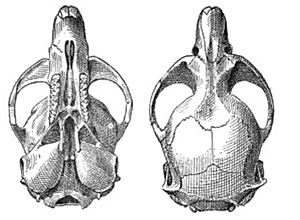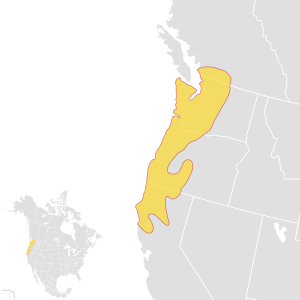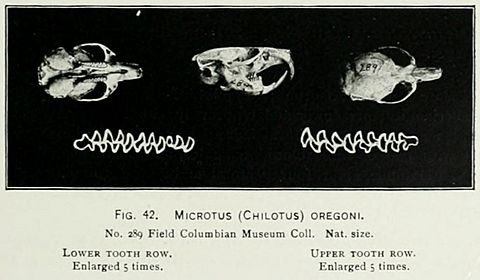Creeping vole facts for kids
Quick facts for kids Creeping vole |
|
|---|---|
 |
|
| Conservation status | |
| Scientific classification | |
| Genus: |
Microtus
|
| Species: |
oregoni
|
 |
|
| Distribution of the creeping vole | |
| Synonyms | |
|
List
Arvicola oregoni
Bachman, 1839 M. adocetus Merriam, 1908 M. bairdii Merriam, 1897 M. cantwelli Taylor, 1920 M. morosus Elliot, 1899 M. oregoni Miller, 1896 M. serpens Merriam, 1897 |
|
The creeping vole (Microtus oregoni) is a small rodent that lives in the Pacific Northwest of North America. It is also sometimes called the Oregon meadow mouse. You can find these furry, brownish-gray mammals in forests, grasslands, woodlands, and chaparral areas.
Scientists first described the creeping vole in 1839. The first one studied was found near the Columbia River. This vole is the smallest of its kind in the areas where it lives. It usually weighs about 19 g (0.67 oz). When baby voles are born, they weigh only 1.6 g (0.056 oz). They are born without fur, their eyes are closed, and their ears are covered. Even though they are not always common, there are no big worries about their survival as a species.
Contents
What is a Creeping Vole?
The creeping vole is a type of rodent. It belongs to a group of animals called voles. Scientists gave it the name Microtus oregoni.
How Scientists Named the Creeping Vole
A scientist named John Bachman first described this animal in 1839. He first called it Arvicola oregoni. The first vole he studied was an older male. It was found on November 2, 1836, near the mouth of the Columbia River in Oregon. This place is now known as Astoria, Oregon. Later, scientists decided to put this animal in the group called Microtus. This is how it got its current scientific name, Microtus oregoni.
How to Identify a Creeping Vole
Creeping voles are quite small. They usually weigh around 19 g (0.67 oz). Their weight can range from 14.5 to 27.5 g (0.51 to 0.97 oz). They are about 140 mm (5.5 in) long, which is about 5.5 in (140 mm). Their length can be from 129 to 154 mm (5.1 to 6.1 in).
Size and Appearance
Compared to other voles in the same area, creeping voles are the smallest. They have small eyes, about 2 mm (0.079 in) wide. Their fur is usually dark brown or black, but sometimes it has yellowish hairs. Their belly fur is lighter, often beige or whitish.
They have a short tail, which is less than 30% of their total body length. Their tail can be gray or black, and it is often lighter underneath. Their ears are also short and have very little hair. They stick out just a little bit from the fur on their head.
Feet and Skull Features
Creeping voles have five toes on each foot. They walk with their whole foot flat on the ground. Their foot pads have some fur.
The skull of a creeping vole is low and flat. It has a long, thin snout. They also have small molar teeth.
Where Creeping Voles Live
Creeping voles live in British Columbia in Canada. They are also found in Washington, Oregon, and northern California in the United States. Their range goes as far north as Port Moody, British Columbia and as far south as Mendocino, California.
Preferred Homes
You can find these voles in different types of places. They live in coniferous forests, woodlands, grasslands, and chaparral areas. They can live from sea level up to almost 2,400 m (7,900 ft) high in the mountains.
Creeping voles like areas that have been disturbed, more than very old, untouched forests. They are good at digging burrows, which are shallow. They also use fallen logs, other natural debris, and patches of grass to hide. They prefer moist forests near the coast, but they can also do well in drier places.
Creeping Vole Habits
Creeping voles build their nests out of dry grass. They usually place these nests in safe spots, like under logs.
Breeding and Babies
The time of year when they have babies changes depending on where they live. In Oregon and British Columbia, they mostly breed from March to September. A mother vole is pregnant for about 23 days. Each time, she has three to four babies. A female vole can have four or five litters of babies in a year. As mentioned, newborn voles are pink, have no fur, and their eyes and ears are closed.
Daily Life and Diet
Creeping voles are mostly active at night. However, you might sometimes see them moving around during the day. They are herbivores, meaning they eat plants. They probably eat different kinds of forbs (flowering plants that are not grasses) and grasses. They also eat fungi.
Are Creeping Voles in Danger?
The creeping vole is listed as "Least Concern" by the IUCN Red List. This means that scientists are not worried about them becoming extinct. Even though they are not found everywhere and are not always common, their numbers are stable. They can also adapt well to changes in their environment.
For example, treating Douglas-fir tree farms with chemicals in British Columbia did not harm the creeping vole populations. There are enough protected areas where they live, so no special conservation efforts are needed right now.
See also
 In Spanish: Microtus oregoni para niños
In Spanish: Microtus oregoni para niños



